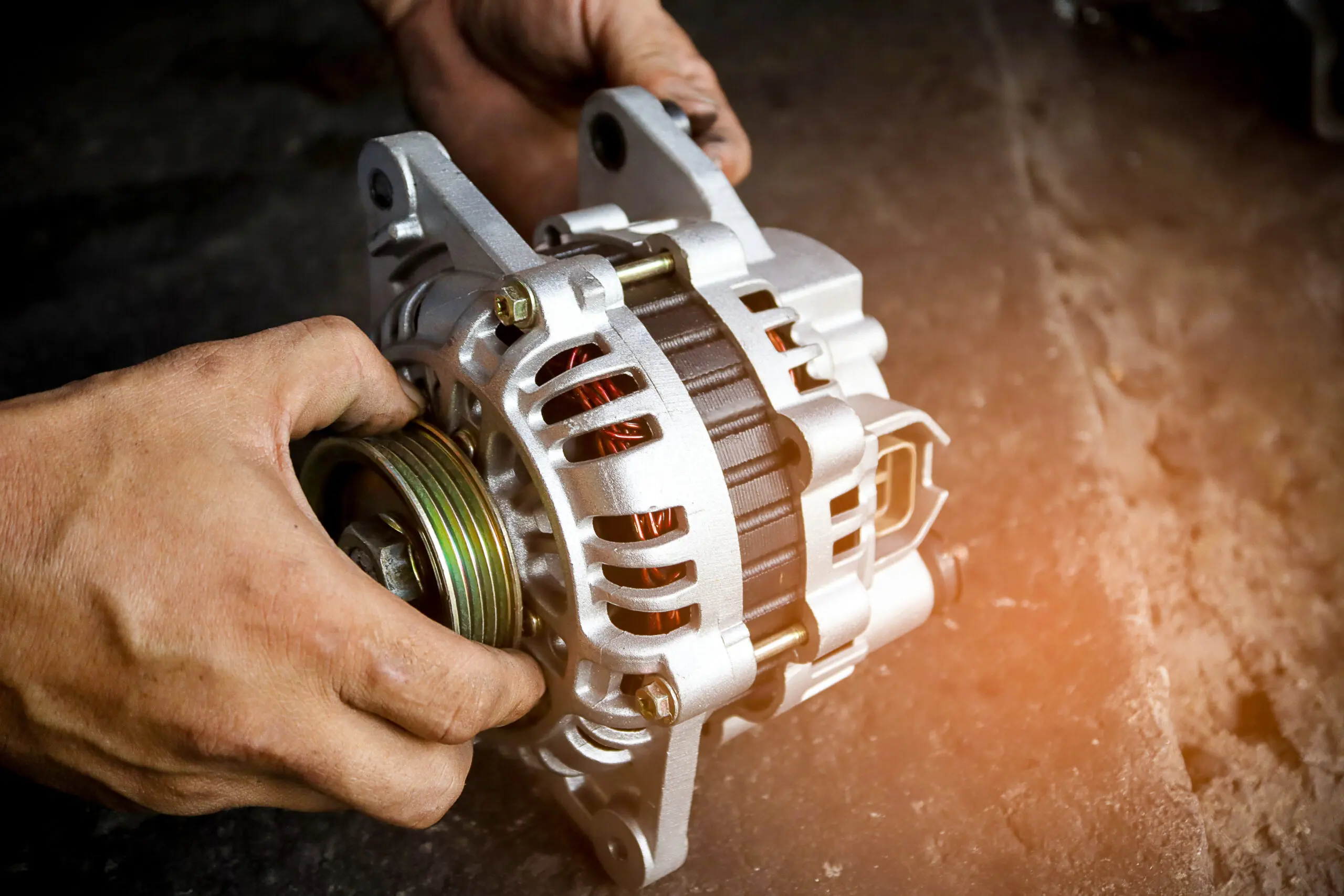Avoiding Alternator Repairs
The alternator in your vehicle is an essential part of keeping it running — literally. It’s responsible for keeping the car going while the engine is on and supplying power to many of the electrical components while driving or idling, several of which are essential for safety. Although this part is designed to last anywhere between several years or up to the vehicle’s lifetime (especially when checked as part of routine vehicle maintenance) alternators can go bad due to various causes. When they do begin to fail, there are a variety of bad alternator symptoms your vehicle may exhibit signaling that it’s time for a replacement.
What Does an Automobile’s Alternator Do?
Your vehicle’s alternator works with the battery to keep it moving and working as it should. It’s responsible for powering various electronic components using direct current (DC) power, including headlights, power windows, power steering, windshield wipers, dashboard, radio, and, if equipped, heated seats. The alternator also charges your battery as you drive.
Essentially, an alternator turns mechanical energy into electrical energy via a drive belt from the engine. As the drive belt moves, the pulley attached to the alternator turns a rotor shaft, spinning a set of magnets around a coil to generate alternating current (AC) around it which then is channeled to the rectifier. This rectifier converts the AC power to the DC power that powers your vehicle’s electrical power systems. For a more in-depth look, check out this alternator wiring diagram.
Reasons an Alternator Goes Bad
Your car’s alternator is intended to last for the vehicle’s life, but various reasons may cause it to fail prematurely.
Here are the most common:
- Use-related wear
- Leaking engine oil or power steering fluid onto the alternator
- Prolonged idling while using several of the car’s accessories at once
- Water exposure
- Age of the alternator
How Often Does a Car Alternator Need Replacement?
On average, alternators last about seven years or 150,000 miles. This may change depending on the quality of the part, overall vehicle condition, and use of internal electronics. The car alternator repair cost will vary, as well, depending on the model of alternator needed, if a new serpentine belt is required, and how much the dealership or automotive shop charges for parts and labor.
Preventing Alternator Failure
Thankfully, when it comes to avoiding car alternator replacement, there are several ways you can ensure your alternator doesn’t bite the dust before its time.
- Watch for red flags. Any warning signs your car is showing, like those listed in the section below, be sure to listen. Make any repairs as soon as you can!
- Need a jump? Do it right. Improperly jump starting an engine can end up frying the alternator, so if you need a jump and aren’t totally sure what to do, ask for assistance.
- Properly install any aftermarket electronics. Improperly installing any new, high-tech electronics can overload the alternator, so follow all instructions carefully or have it installed by professionals.
- Watch for fluid leaks. Keep up with routine vehicle inspections and maintenance to ensure there’s not an unnoticed leak slowly ruining your alternator.
- If you need to replace the alternator, buy new. It’s always great to save some money, but when it comes to your alternator, it’s worth a little extra to buy a new one rather than one that has been “remanufactured.”
- Always use caution when jumping a car’s battery. Make sure you know the proper way to jump-start the car; an improper jump can fry the alternator.
- Watch out for fluid leaks in the alternator. Having the vehicle inspected routinely can keep you alert to this.
- Never ignore warning signs of a bad battery (a dashboard warning light or dimming headlights.) Have the problem addressed right away, the issue may be the alternator and not the battery itself.
Signs of a Bad Alternator
There are various signs you may experience if your car alternator fails. These are often confused with a dying or dead battery, so it’s important to check your vehicle’s engine as soon as possible if you see any of the following warning signs.
Dim or Very Bright Headlights
A failing alternator sends inconsistent voltage to the electronic accessories, resulting in over- or under-performing equipment. The headlights may begin to put out much dimmer light when there’s not enough power. On the other hand, providing too much power can make your headlights extremely bright. A failing alternator may also cause the headlights to flicker or go back and forth between bright and dim as you drive.
Dead Battery
A dead battery doesn’t always mean your car’s alternator is going bad as the batteries have their own lifespan, or can quickly be drained by leaving lights on for a prolonged period without the engine running. However, a failing alternator can result in a dead battery as it’s not sufficiently charging it while the engine runs. Luckily, there’s a fairly simple way you can diagnose whether this issue is caused by a truly dying battery or a bad alternator.
Jumpstart your vehicle. If you do this and the car continues running, it’s most likely the battery you’ll want to replace soon. If the vehicle ends up dying again soon after jump starting, the alternator likely is not sending enough power to the battery.
Slow or Malfunctioning Electronic Accessories
When the alternator isn’t supplying enough power to the car’s electronics, you end up with slow or non-functioning accessories. This could come in the form of windows slowly rolling up or down, heated seats taking a long time to warm, or an erratically behaving speedometer (or other dashboard instruments). Most new vehicles are equipped with an equipment priority list that alerts the onboard computer of which systems to cut power to first in the event of a failing alternator. This is viewed as a safety feature because you’ll lose power to nonessential accessories, like the radio or heated seats, before losing power to those that keep you safe, like headlights or steering.
Difficulty Starting the Vehicle or Experiencing Frequent Stalls
As mentioned within the dead battery section, you may have trouble starting your engine if the alternator is not providing a sufficient charge. Turning your key in the ignition may simply leave you with a strange clicking sound instead of a running engine. A failing alternator may also cause your car to stall frequently while driving, which is caused by the spark plugs and coils not getting enough power.
Strange Sounds or Burning Smells
Sometimes, cars just make odd noises. While some are no cause for concerns, others can point to significant mechanical problems. A faulty alternator, for instance, can create growling or whining sounds from your vehicle’s engine. This sound can be caused by a misalignment of the drive belt attached to the alternator’s pulley. These growling or whining sounds may also be heard if the bearings that spin the rotor shaft are going bad.
In addition to sounds, you may encounter some strange smells, too. The alternator’s drive belt is under constant tension and friction and runs closely to the hot engine, causing it to wear out over time. This wear may begin smelling like burning rubber. You may also smell burning rubber or wires if other parts of the alternator are wearing out, or if you have a seized alternator pulley bearing.
If you smell something similar to an electrical fire, your alternator is most likely being overworked or has frayed or damaged wires. This occurs when an overworked alternator attempts to push too much electricity through the wires and cause them to heat up drastically, resulting in damage. Once damaged, the wires will resist the flow of electricity, generating more heat and emitting a foul odor.
Dashboard Battery Warning Light Illuminates
Every vehicle should be equipped with a battery warning light on the dashboard. However, just because it illuminates, it doesn’t always mean the issue is limited to the battery. This warning light may indicate an issue with something in the car’s electrical system, including the alternator.
The alternator is designed to work at a specific voltage, usually between 13-14.5 volts. A failing alternator may result in a voltage drop below capacity or exceed its voltage limit if under a lot of stress, both of which will trigger the battery warning light. If the alternator fluctuates in and out of the intended voltage capacity, particularly if using several electrical components simultaneously, the battery warning light may flicker intermittently.
Avoid an Untimely Alternator Replacement with the Right Maintenance
The alternator is an essential part of your vehicle, and keeping it running as it should will keep your vehicle safely on the road. Keeping up with routine vehicle maintenance can help prevent problems that prematurely kill the alternator. In the event you begin experiencing signs of a bad alternator, be sure to have it checked right away by an experienced mechanic.
Need regular vehicle maintenance or diagnostics performed on your vehicle? Contact Telle Tire, or walk-in to a location near you!



